算法导论求n个点的最小距离
- 格式:doc
- 大小:124.00 KB
- 文档页数:21
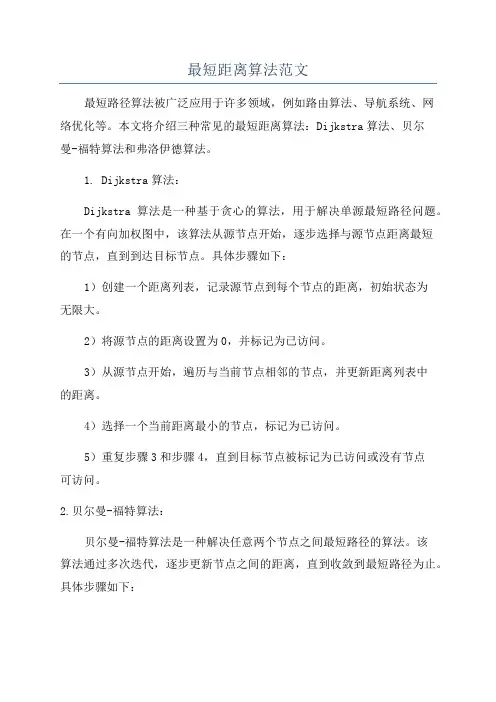
最短距离算法范文最短路径算法被广泛应用于许多领域,例如路由算法、导航系统、网络优化等。
本文将介绍三种常见的最短距离算法:Dijkstra算法、贝尔曼-福特算法和弗洛伊德算法。
1. Dijkstra算法:Dijkstra算法是一种基于贪心的算法,用于解决单源最短路径问题。
在一个有向加权图中,该算法从源节点开始,逐步选择与源节点距离最短的节点,直到到达目标节点。
具体步骤如下:1)创建一个距离列表,记录源节点到每个节点的距离,初始状态为无限大。
2)将源节点的距离设置为0,并标记为已访问。
3)从源节点开始,遍历与当前节点相邻的节点,并更新距离列表中的距离。
4)选择一个当前距离最小的节点,标记为已访问。
5)重复步骤3和步骤4,直到目标节点被标记为已访问或没有节点可访问。
2.贝尔曼-福特算法:贝尔曼-福特算法是一种解决任意两个节点之间最短路径的算法。
该算法通过多次迭代,逐步更新节点之间的距离,直到收敛到最短路径为止。
具体步骤如下:1)创建一个距离列表,记录源节点到每个节点的初始距离,初始状态为无限大。
2)将源节点的距离设置为0。
3)重复以下步骤N-1次(N为图中节点的个数):a)遍历图中的每条边,如果当前边的权重与源节点到边的起点的距离之和小于边的终点的距离,则更新边终点的距离。
4)遍历图中的每条边,如果存在一条边满足上述条件,则图中存在负权重环,算法无法得出最短路径。
5)如果没有负权重环,则距离列表即为最短路径。
3.弗洛伊德算法:弗洛伊德算法是一种解决任意两个节点之间最短路径的算法。
该算法通过多次迭代,逐步更新节点之间的距离,直到收敛到最短路径为止。
与贝尔曼-福特算法不同的是,弗洛伊德算法可以处理含有负权重边的图。
具体步骤如下:1)创建一个邻接矩阵,用于记录每对节点之间的初始距离。
2)通过多次迭代,根据节点之间的中间节点更新距离矩阵。
3)重复以下步骤N次(N为图中节点的个数):a)遍历图中的每对节点,如果当前节点之间的距离大于通过一些中间节点的距离之和,则更新距离矩阵中的距离。
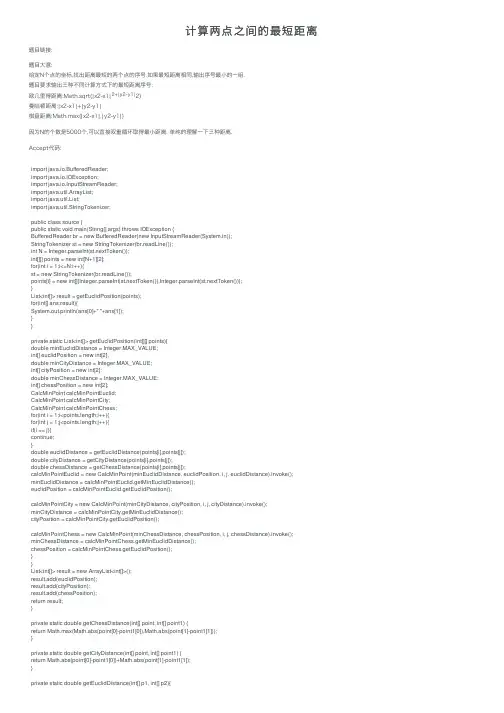
计算两点之间的最短距离题⽬链接:题⽬⼤意:给定N个点的坐标,找出距离最短的两个点的序号.如果最短距离相同,输出序号最⼩的⼀组.题⽬要求输出三种不同计算⽅式下的最短距离序号:欧⼏⾥得距离:Math.sqrt(|x2-x1|2+|y2-y1|2)曼哈顿距离:|x2-x1|+|y2-y1|棋盘距离:Math.max(|x2-x1|,|y2-y1|)因为N的个数是5000个,可以直接双重循环取得最⼩距离. 单纯的理解⼀下三种距离.Accept代码:import java.io.BufferedReader;import java.io.IOException;import java.io.InputStreamReader;import java.util.ArrayList;import java.util.List;import java.util.StringTokenizer;public class source {public static void main(String[] args) throws IOException {BufferedReader br = new BufferedReader(new InputStreamReader(System.in));StringTokenizer st = new StringTokenizer(br.readLine());int N = Integer.parseInt(st.nextToken());int[][] points = new int[N+1][2];for(int i = 1;i<=N;i++){st = new StringTokenizer(br.readLine());points[i] = new int[]{Integer.parseInt(st.nextToken()),Integer.parseInt(st.nextToken())};}List<int[]> result = getEuclidPosition(points);for(int[] ans:result){System.out.println(ans[0]+" "+ans[1]);}}private static List<int[]> getEuclidPosition(int[][] points){double minEuclidDistance = Integer.MAX_VALUE;int[] euclidPosition = new int[2];double minCityDistance = Integer.MAX_VALUE;int[] cityPosition = new int[2];double minChessDistance = Integer.MAX_VALUE;int[] chessPosition = new int[2];CalcMinPoint calcMinPointEuclid;CalcMinPoint calcMinPointCity;CalcMinPoint calcMinPointChess;for(int i = 1;i<points.length;i++){for(int j = 1;j<points.length;j++){if(i == j){continue;}double euclidDistance = getEuclidDistance(points[i],points[j]);double cityDistance = getCityDistance(points[i],points[j]);double chessDistance = getChessDistance(points[i],points[j]);calcMinPointEuclid = new CalcMinPoint(minEuclidDistance, euclidPosition, i, j, euclidDistance).invoke(); minEuclidDistance = calcMinPointEuclid.getMinEuclidDistance();euclidPosition = calcMinPointEuclid.getEuclidPosition();calcMinPointCity = new CalcMinPoint(minCityDistance, cityPosition, i, j, cityDistance).invoke(); minCityDistance = calcMinPointCity.getMinEuclidDistance();cityPosition = calcMinPointCity.getEuclidPosition();calcMinPointChess = new CalcMinPoint(minChessDistance, chessPosition, i, j, chessDistance).invoke(); minChessDistance = calcMinPointChess.getMinEuclidDistance();chessPosition = calcMinPointChess.getEuclidPosition();}}List<int[]> result = new ArrayList<int[]>();result.add(euclidPosition);result.add(cityPosition);result.add(chessPosition);return result;}private static double getChessDistance(int[] point, int[] point1) {return Math.max(Math.abs(point[0]-point1[0]),Math.abs(point[1]-point1[1]));}private static double getCityDistance(int[] point, int[] point1) {return Math.abs(point[0]-point1[0])+Math.abs(point[1]-point1[1]);}private static double getEuclidDistance(int[] p1, int[] p2){return Math.pow(p1[0]-p2[0],2)+Math.pow(p1[1]-p2[1],2);}private static class CalcMinPoint {private double minEuclidDistance;private int[] euclidPosition;private int i;private int j;private double euclidDistance;public CalcMinPoint(double minEuclidDistance, int[] euclidPosition, int i, int j, double euclidDistance) { this.minEuclidDistance = minEuclidDistance;this.euclidPosition = euclidPosition;this.i = i;this.j = j;this.euclidDistance = euclidDistance;}public double getMinEuclidDistance() {return minEuclidDistance;}public int[] getEuclidPosition() {return euclidPosition;}public CalcMinPoint invoke() {if(minEuclidDistance > euclidDistance){minEuclidDistance = euclidDistance;if(i < j){euclidPosition = new int[]{i,j};}else{euclidPosition = new int[]{j,i};}}else if(minEuclidDistance == euclidDistance){int position0 = -1;int position1 = -1;if(i<j){ position0 = i; position1 = j; } else{ position0 = j; position1 = i; } if(euclidPosition[0]>position0){ euclidPosition = new int[]{position0,position1};}else if(euclidPosition[0] == position0 && euclidPosition[1]>position1){euclidPosition = new int[]{position0,position1};}}return this;}}}。
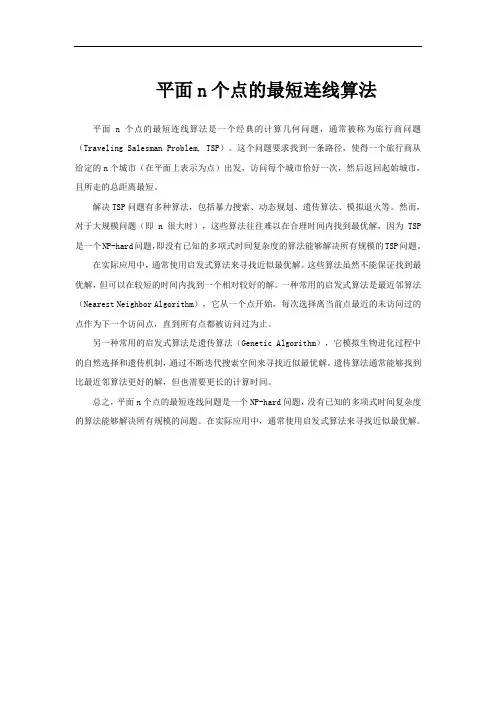
平面n个点的最短连线算法
平面n个点的最短连线算法是一个经典的计算几何问题,通常被称为旅行商问题(Traveling Salesman Problem, TSP)。
这个问题要求找到一条路径,使得一个旅行商从给定的n个城市(在平面上表示为点)出发,访问每个城市恰好一次,然后返回起始城市,且所走的总距离最短。
解决TSP问题有多种算法,包括暴力搜索、动态规划、遗传算法、模拟退火等。
然而,对于大规模问题(即n很大时),这些算法往往难以在合理时间内找到最优解,因为TSP 是一个NP-hard问题,即没有已知的多项式时间复杂度的算法能够解决所有规模的TSP问题。
在实际应用中,通常使用启发式算法来寻找近似最优解。
这些算法虽然不能保证找到最优解,但可以在较短的时间内找到一个相对较好的解。
一种常用的启发式算法是最近邻算法(Nearest Neighbor Algorithm),它从一个点开始,每次选择离当前点最近的未访问过的点作为下一个访问点,直到所有点都被访问过为止。
另一种常用的启发式算法是遗传算法(Genetic Algorithm),它模拟生物进化过程中的自然选择和遗传机制,通过不断迭代搜索空间来寻找近似最优解。
遗传算法通常能够找到比最近邻算法更好的解,但也需要更长的计算时间。
总之,平面n个点的最短连线问题是一个NP-hard问题,没有已知的多项式时间复杂度的算法能够解决所有规模的问题。
在实际应用中,通常使用启发式算法来寻找近似最优解。
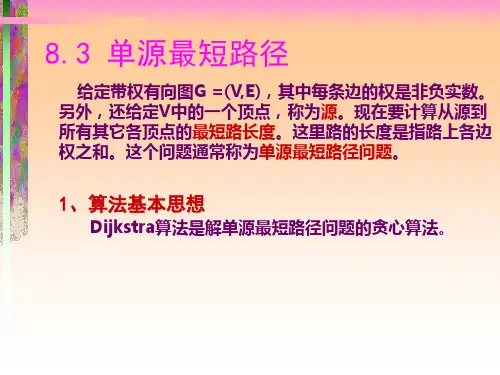
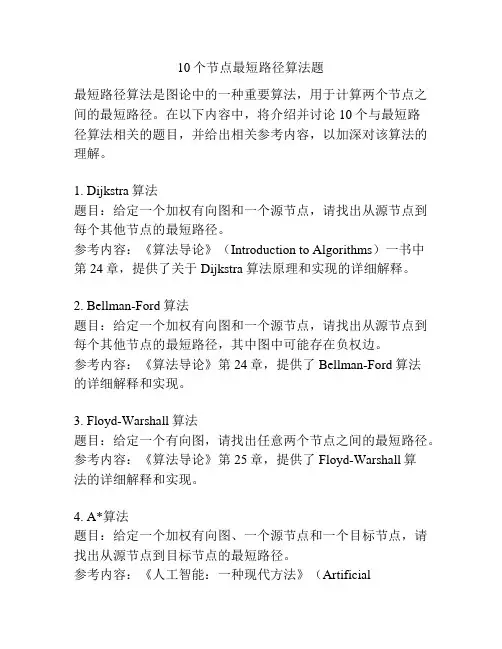
10个节点最短路径算法题最短路径算法是图论中的一种重要算法,用于计算两个节点之间的最短路径。
在以下内容中,将介绍并讨论10个与最短路径算法相关的题目,并给出相关参考内容,以加深对该算法的理解。
1. Dijkstra算法题目:给定一个加权有向图和一个源节点,请找出从源节点到每个其他节点的最短路径。
参考内容:《算法导论》(Introduction to Algorithms)一书中第24章,提供了关于Dijkstra算法原理和实现的详细解释。
2. Bellman-Ford算法题目:给定一个加权有向图和一个源节点,请找出从源节点到每个其他节点的最短路径,其中图中可能存在负权边。
参考内容:《算法导论》第24章,提供了Bellman-Ford算法的详细解释和实现。
3. Floyd-Warshall算法题目:给定一个有向图,请找出任意两个节点之间的最短路径。
参考内容:《算法导论》第25章,提供了Floyd-Warshall算法的详细解释和实现。
4. A*算法题目:给定一个加权有向图、一个源节点和一个目标节点,请找出从源节点到目标节点的最短路径。
参考内容:《人工智能:一种现代方法》(ArtificialIntelligence: A Modern Approach)一书中第3章,提供了A*算法的详细解释和实现。
5. Johnson算法题目:给定一个加权有向图,请找出任意两个节点之间的最短路径,其中图中可能存在负权边。
参考内容:《算法导论》第25章,提供了Johnson算法的详细解释和实现。
6. SPFA算法题目:给定一个加权有向图和一个源节点,请找出从源节点到每个其他节点的最短路径。
参考内容:各种算法教材、博客文章和论文中提供了SPFA算法的详细解释和实现,如《算法导论》第24章。
7. Yen's算法题目:给定一个加权有向图、一个源节点和一个目标节点,请找出从源节点到目标节点的K条最短路径。
参考内容:论文《Finding the K Shortest Loopless Paths in a Network》中提供了Yen's算法的详细解释和实现。
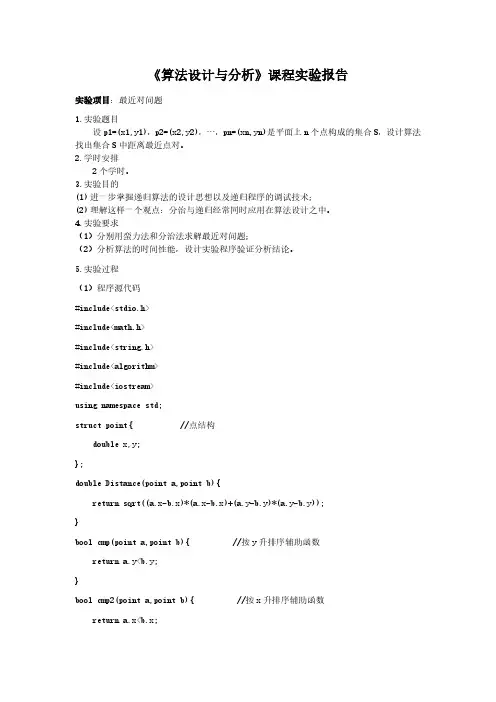
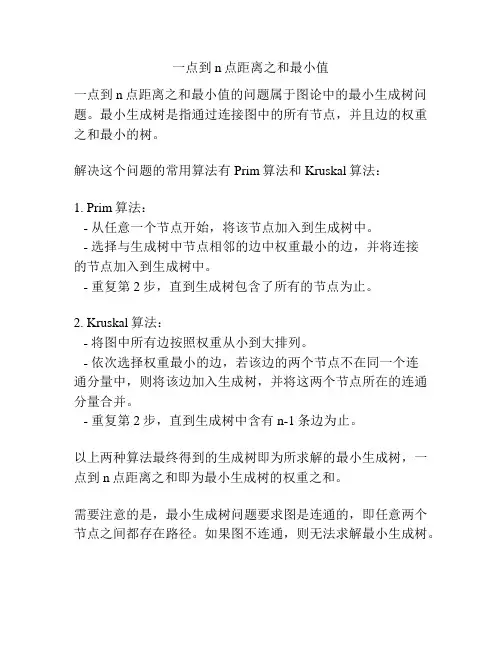
一点到n点距离之和最小值
一点到n点距离之和最小值的问题属于图论中的最小生成树问题。
最小生成树是指通过连接图中的所有节点,并且边的权重之和最小的树。
解决这个问题的常用算法有Prim算法和Kruskal算法:
1. Prim算法:
- 从任意一个节点开始,将该节点加入到生成树中。
- 选择与生成树中节点相邻的边中权重最小的边,并将连接
的节点加入到生成树中。
- 重复第2步,直到生成树包含了所有的节点为止。
2. Kruskal算法:
- 将图中所有边按照权重从小到大排列。
- 依次选择权重最小的边,若该边的两个节点不在同一个连
通分量中,则将该边加入生成树,并将这两个节点所在的连通分量合并。
- 重复第2步,直到生成树中含有n-1条边为止。
以上两种算法最终得到的生成树即为所求解的最小生成树,一点到n点距离之和即为最小生成树的权重之和。
需要注意的是,最小生成树问题要求图是连通的,即任意两个节点之间都存在路径。
如果图不连通,则无法求解最小生成树。
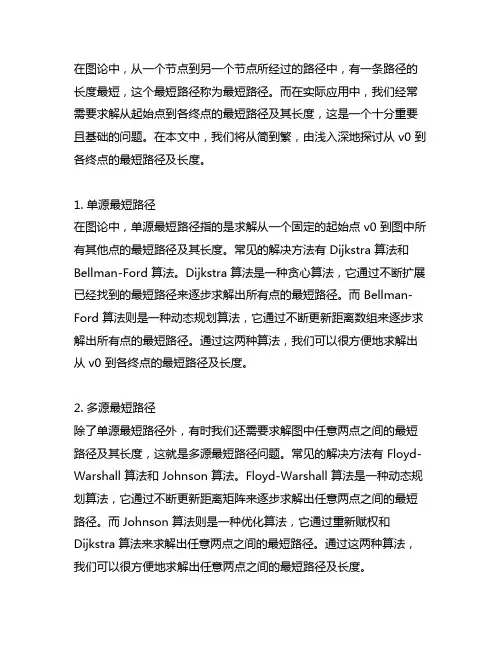
在图论中,从一个节点到另一个节点所经过的路径中,有一条路径的长度最短,这个最短路径称为最短路径。
而在实际应用中,我们经常需要求解从起始点到各终点的最短路径及其长度,这是一个十分重要且基础的问题。
在本文中,我们将从简到繁,由浅入深地探讨从 v0 到各终点的最短路径及长度。
1. 单源最短路径在图论中,单源最短路径指的是求解从一个固定的起始点 v0 到图中所有其他点的最短路径及其长度。
常见的解决方法有 Dijkstra 算法和Bellman-Ford 算法。
Dijkstra 算法是一种贪心算法,它通过不断扩展已经找到的最短路径来逐步求解出所有点的最短路径。
而 Bellman-Ford 算法则是一种动态规划算法,它通过不断更新距离数组来逐步求解出所有点的最短路径。
通过这两种算法,我们可以很方便地求解出从 v0 到各终点的最短路径及长度。
2. 多源最短路径除了单源最短路径外,有时我们还需要求解图中任意两点之间的最短路径及其长度,这就是多源最短路径问题。
常见的解决方法有 Floyd-Warshall 算法和 Johnson 算法。
Floyd-Warshall 算法是一种动态规划算法,它通过不断更新距离矩阵来逐步求解出任意两点之间的最短路径。
而 Johnson 算法则是一种优化算法,它通过重新赋权和Dijkstra 算法来求解出任意两点之间的最短路径。
通过这两种算法,我们可以很方便地求解出任意两点之间的最短路径及长度。
3. 应用实例分析在实际应用中,最短路径问题有着广泛的应用。
比如在交通规划中,我们需要求解出从一个城市到另一个城市的最短路径及长度,以便合理规划交通路线。
在网络通信中,我们需要求解出从一个网络节点到另一个网络节点的最短路径及长度,以便提高数据传输效率。
在人工智能中,我们需要求解出从一个状态到另一个状态的最短路径及长度,以便优化决策过程。
通过对最短路径问题的研究和应用,我们可以更好地理解和解决实际问题。

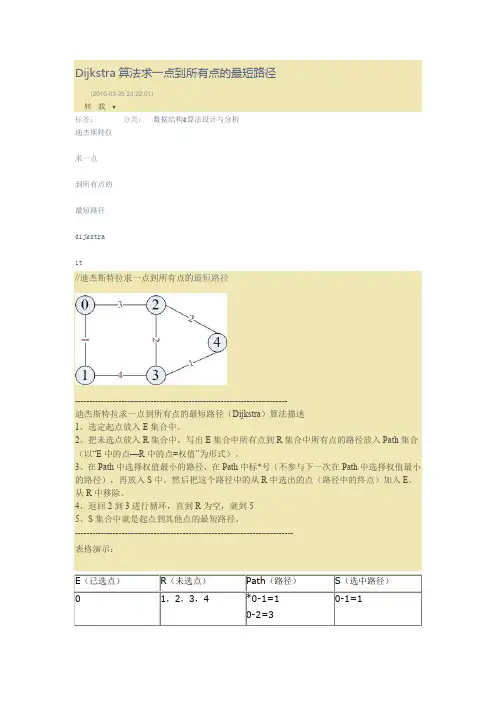
Dijkstra 算法求一点到所有点的最短路径(2010-03-25 23:22:01) 转载▼标签: 迪杰斯特拉 求一点 到所有点的 最短路径 dijkstra it分类:数据结构&算法设计与分析//迪杰斯特拉求一点到所有点的最短路径------------------------------------------------------------------------- 迪杰斯特拉求一点到所有点的最短路径(Dijkstra )算法描述 1、选定起点放入E 集合中。
2、把未选点放入R 集合中,写出E 集合中所有点到R 集合中所有点的路径放入Path 集合(以“E 中的点—R 中的点=权值”为形式)。
3、在Path 中选择权值最小的路径,在Path 中标*号(不参与下一次在Path 中选择权值最小的路径),再放入S 中。
然后把这个路径中的从R 中选出的点(路径中的终点)加入E ,从R 中移除。
4、返回2到3进行循环,直到R 为空,就到55、S 集合中就是起点到其他点的最短路径。
--------------------------------------------------------------------------- 表格演示:--------------------------------------------------------------------------------------------- 最终生成的树结构转化为以下的表结构:(在代码中对应的是Tree数组)//4<-2<-0//3<-2<-0//3<-1<-0//2<-0//1<-0----------------------------------------------------------------------------------------------//Java代码//class Tree{int id=0;int root=0;int right=0;int flag=0;public void setAll(int id,int ro,int ri,int fl){this.flag=fl;this.id=id;this.right=ri;this.root=ro;}public void setFlag(int flag) {this.flag = flag;}public void setId(int id) {this.id = id;}public void setRight(int right) {this.right = right;}public void setRoot(int root) {this.root = root;}public void get_r(Tree t){this.flag=t.flag;this.id=t.id;this.right=t.right;this.root=t.root;}public boolean equals(Tree t){if((this.flag==t.flag)&&(this.id==t.id)&&(this.right==t.right)&&(this.root==t.root)){ return true;}else{return false;}}public boolean isZero(){if((this.flag==0)&&(this.id==0)&&(this.right==0)&&(this.root==0)){ return true;}else{return false;}}}class RESet{int id=0;int flag=0;public void setId(int id){this.id=id;}public void setFlag(int flag){this.flag=flag;}}public class DijkstraFindRoad {static int node[][]={//0, 1, 2, 3, 4{99, 1, 3,99,99},{ 1,99,99, 4,99},{ 3,99,99, 2, 2},{99, 4, 2,99, 1},{99,99, 2, 1,99}};public DijkstraFindRoad(){}public static int printRoad(Tree []t,int i){//打印路径System.out.print("<-"+t[ getRtNum_r(t,t[i])].id);if(t[i].right==99){return 0;}else{printRoad(t, getRtNum_r(t,t[ getRtNum_r(t,t[i])]));}return 1;}public static void removeSameValue(Tree []tq){/////去除重复int flag=0,j=0;for(int i=0;i<tq.length;i++){for(j=0;j<tq.length;j++){if(tq[i].equals(tq[j])&&(!tq[i].isZero())){flag=i;}}}tq[flag].setAll(0,0,0,0);}public static int getRtNum_r(Tree[] tq,Tree t){//取得t的根的物理地址int rti=0;for(int i=0;i<tq.length;i++){if(t.root==tq[i].id){rti=i;break;}}return rti;}public static boolean isRoadFull(Tree[] t,RESet []rs){//是否所有路径都已选择 int counter=0;for(int i=1;i<t.length;i++){if(t[i].flag==1)counter++;}if(rs.length==counter){return true;}return false;}public static void main(String args[]){Tree t[]=new Tree[20];Tree temp=new Tree();//做交换用RESet res[]=new RESet[5];int start=0;//指定起点,从0点开始//////////////////////////////////////初始化for(int i=0;i<res.length;i++){res[i]=new RESet();res[i].setId(i);}for(int i=0;i<t.length;i++){t[i]=new Tree();}res[start].setFlag(2);t[0].setId(start);t[0].setRoot(0);t[0].setRight(99);t[0].setFlag(0);//////////////////////////////////////int ti=1;int j=0;int xi=0,yj=0,counter=0;ti=1;while(true){//////////////////////////////////////////////////yj=0;for(int i=0;i<res.length;i++){if(res[i].flag==0) yj++;}xi=res.length-yj;//System.out.println("xi:"+xi+" "+"yj:"+yj+"||ti:"+ti);//////////////////////////////////////选取点操作int ii=xi-1,nbeg=ti,nend=0;for(j=xi-1;j<res.length;j++){//1if(node[ii][j]!=99){//ift[ti].setId(j);t[ti].setRoot(ii);t[ti].setRight(node[ii][j]);ti++;}//if}//1nend=ti;//////////////////////////////////////////加权操作//System.out.println("ROOT:"+ getRtNum_r(t,t[4])); for(int i=nbeg;i<nend;i++){if(t[i].root!=0){t[i].setRight(t[ getRtNum_r(t,t[i])].right+t[i].right);}}/////////////////////////////////////////选最小权值int min=99;int f=0;for(int i=0;i<t.length;i++){if((t[i].right!=0)&&(t[i].flag!=1)&&(t[i].right<min)){ min=t[i].right;f=i;}}///////////////////////////////////////选最小权值,做标记t[f].setFlag(1);res[t[f].id].flag=1;/////////////////////////////////////////System.out.println("11111:"+t[f].id+":"+t[f].root+":"+t[f].right+":"+t[f].flag); //////////////////////////////////////////////////////////////////////////////////if(isRoadFull(t,res))break;}/////////////////////////////////////////////removeSameValue(t);////////////////////////////////////////////////////////////////////////////////////////// for(int si=0;si<res.length;si++){// System.out.println(res[si].id+":"+res[si].flag);// }// for(int si=0;si<t.length;si++){// System.out.println(t[si].id+":"+t[si].root+":"+t[si].right+":"+t[si].flag);// }//////////////////////////////////////打印路径int n=res.length;for(int i=n;i>0;i--){System.out.print(t[i].id);printRoad(t,i);System.out.println();}}}。
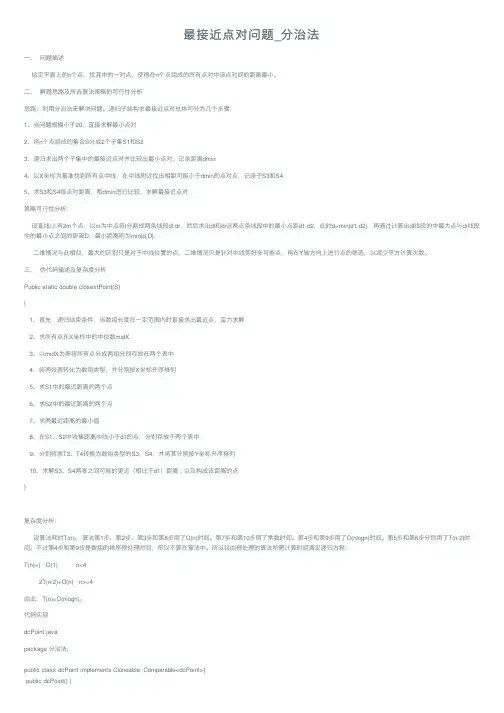
最接近点对问题_分治法⼀、问题描述给定平⾯上的n个点,找其中的⼀对点,使得在n个点组成的所有点对中该点对间的距离最⼩。
⼆、解题思路及所选算法策略的可⾏性分析思路:利⽤分治法来解决问题。
递归⼦结构求最接近点对总体可分为⼏个步骤:1、当问题规模⼩于20,直接求解最⼩点对2、将n个点组成的集合S分成2个⼦集S1和S23、递归求出两个⼦集中的最接近点对并⽐较出最⼩点对,记录距离dmin4、以X坐标为基准找到所有点中线,在中线附近找出相距可能⼩于dmin的点对点,记录于S3和S45、求S3和S4每点对距离,和dmin进⾏⽐较,求解最接近点对策略可⾏性分析:设直线l上有2m个点,以m为中点将l分割成两条线段dl,dr,然后求出dl和dr这两点条线段中的最⼩点距d1,d2,此时d=min{d1,d2},再通过计算出dl线段的中最⼤点与dr线段中的最⼩点之间的距离D,最⼩距离则为min{d,D}.⼆维情况与此相似,最⼤的区别只是对于中线位置的点,⼆维情况只是针对中线旁好多可能点,再在Y轴⽅向上进⾏点的筛选,以减少平⽅计算次数。
三、伪代码描述及复杂度分析Public static double closestPoint(S){1、⾸先,递归结束条件,当数组长度在⼀定范围内时直接求出最近点,蛮⼒求解2、求所有点在X坐标中的中位数midX3、以midX为界将所有点分成两组分别存放在两个表中4、将两张表转化为数组类型,并分别按X坐标升序排列5、求S1中的最近距离的两个点6、求S2中的最近距离的两个点7、求两最近距离的最⼩值8、在S1、S2中收集距离中线⼩于d1的点,分别存放于两个表中9、分别将表T3、T4转换为数组类型的S3、S4,并将其分别按Y坐标升序排列10、求解S3、S4两者之间可能的更近(相⽐于d1)距离 , 以及构成该距离的点}复杂度分析:设算法耗时T(n)。
算法第1步、第2步、第3步和第8步⽤了O(n)时间。
距离求和多个点最短算法全文共四篇示例,供读者参考第一篇示例:距离求和多个点最短算法(sum of distances to multiple points shortest algorithm)是一种用于计算一个点到多个给定点的距离之和最短的算法。
这种算法在许多实际问题中都有广泛的应用,比如在路线规划、机器人导航、物流管理等领域。
通过找到一个点到多个给定点的距离之和最短的路径,可以帮助我们更高效地解决实际问题。
在距离求和多个点最短算法中,我们需要先给定多个点的坐标,然后再给定一个起始点,我们的目标是找到从起始点出发到达这些给定点的最短路径。
这种算法类似于最短路径算法,但不同的是,最短路径算法只需要找到一个点到一个点的最短路径,而距离求和多个点最短算法需要找到一个点到多个点的最短路径。
距离求和多个点最短算法有多种不同的实现方法,其中最常用的方法之一是贪心算法。
贪心算法是一种基于局部最优策略来进行全局最优化的算法,它通过每一步都选择当前最优的决策来逐步求解整个问题。
在距离求和多个点最短算法中,我们可以通过贪心算法来逐步选择路径上的下一个点,直到到达所有给定点为止。
另一种常用的方法是动态规划算法。
动态规划算法通常用于求解具有重叠子问题和最优子结构性质的问题,在距离求和多个点最短算法中,我们可以将问题分解为从起始点到每一个给定点的最短路径,并通过动态规划的方式来求解最终的最短路径。
除了贪心算法和动态规划算法,还有其他一些算法可以用于求解距离求和多个点最短问题,比如深度优先搜索算法、广度优先搜索算法、最短路径算法等。
这些算法各有优缺点,具体选择哪种算法取决于实际问题的特点和要求。
在实际应用中,距离求和多个点最短算法可以帮助我们更快速地规划最优路径,减少行车时间和耗费的资源。
比如在物流管理中,通过计算货物到多个客户的最短路径,可以实现快速配送,提高服务质量和客户满意度。
在机器人导航中,通过寻找最短路径可以使机器人更快地到达目的地,提高工作效率。
《算法导论(原书第3版)》第24章部分题⽬解答第24章单源最短路径24.1 Bellman-Ford算法24.1-4思路:先做|V|-1遍松弛操作,然后再做⼀遍松弛操作,对于这次松弛操作中dist值被更新的点,必然包含了每个负环中的⾄少⼀个点。
对于这些点做dfs查找它们能够在图中到达哪些点,所有被搜索到的点即为题⽬要求找的点部分c++代码:#include <bits/stdc++.h>using namespace std;const int maxn = ...;const int inf = 0x3f3f3f3f;//正⽆穷struct E{int x,y,z;//三元组(x,y,z)表⽰⼀条有向边。
从x出发到y,权值为z。
}vector<E> es;//存边vector<int> e[maxn];//模拟邻接链表vector<int> vec;//存起始点void bellman(int s){for(int i = 1; i<=n; i++)d[i]=inf;d[s] = 0;for(int t = 1; t<n; t++){for(auto e:es){if(d[e.x]!=inf && d[e.x]+e.z<d[e.y])d[e.y] = d[e.x] + w;}}for(auto e:es){if(d[e.x]!=inf && d[e.x]+e.z<d[e.y]){vec.push_back(y);}}}int v[maxn];void dfs(int x){v[x] = 1;for(auto y: e){if(!v[y]) dfs(y);}}void solve(int s){bellman(s);for(auto x:vec){if(!v[x]) dfs(x);}for(int i = 1; i<=n; i++){if(v[i]) cout<<"负⽆穷"<<endl;else if(d[i]==inf) cout<<"不可达"<<endl;else cout<<d[i]<<endl;}}24.1-5思路:跑⼀遍Bellman-Ford算法,具体做法如下:1、初始化∀v∈V,d[v]=0。
算法的思想 (2)算法的描述 (2)算法的举例 (2)A*算法 (2)原理简介 (2)详细内容 (2)A*算法误区 (17)A*算法总结(Summary of the A* Method) (17)F LOYD算法 (17)定义 (17)核心思路 (18)算法过程 (18)优缺点分析 (18)J OHNSON算法 (23)Johnson算法要求 (23)Johnson算法结构要求 (23)Johnson算法数据结构 (23)Johnson算法的内容 (23)Johnson算法源程序 (23)D IJKSTRA算法 (27)算法简介 (27)算法描述 (27)复杂度分析 (27)算法实现 (28)测试样例 (30)算法应用的实例 (34)算法的思想设图中有n个结点,设置一个集会u,存放已经求出最短路径的结点(初始时u中的元素是源点),v-u是尚未确定最短路径的顶点的集合。
每次从v-u集合中找这样一个结点best_j:best_j是u集合中结点的邻接点,到源点的距离最短(等于到父结点的距离加上父结点到源点的距离)。
然后把该best_j置入u集合中,直到u=v。
算法的描述最短路经计算分静态最短路计算和动态最短路计算。
静态路径最短路径算法是外界环境不变,计算最短路径。
主要有Dijkstra算法,A*算法。
动态路径最短路是外界环境不断发生变化,即不能计算预测的情况下计算最短路。
典型的有D*算法。
算法的举例A*算法原理简介A*(A-Star)算法是一种静态路网中求解最短路最有效的方法。
公式表示为:f(n)=g(n)+h(n),其中f(n) 是节点n从初始点到目标点的估价函数,g(n) 是在状态空间中从初始节点到n节点的实际代价,h(n)是从n到目标节点最佳路径的估计代价。
保证找到最短路径(最优解的)条件,关键在于估价函数h(n)的选取:估价值h(n)<= n到目标节点的距离实际值,这种情况下,搜索的点数多,搜索范围大,效率低。
python多个点连线的最短路径在过去的一段时间里,我们研究了许多图论中的经典问题。
今天,让我们来探讨一个在实际应用中具有重要意义的问题:多个点连线的最短路径。
在这个问题中,我们需要找到连接多个点的最短路径。
为了解决这个问题,我们将使用Dijkstra算法。
Dijkstra算法是一种单源最短路径算法,主要用于寻找一个有权图中,从源节点到其他所有节点的最短路径。
该算法适用于存在负权边的图,并且可以处理大规模图。
现在,让我们了解一下Dijkstra算法的原理。
Dijkstra算法基于以下思想:从未访问过的节点中,选择距离源节点最近的节点进行访问,并将其加入已访问节点集合。
然后,更新其他未访问节点的距离信息。
这个过程将一直重复,直到所有节点都被访问到,或者源节点到目标节点的最短路径已经找到。
接下来,我们详细介绍Dijkstra算法的实现步骤:1.初始化距离矩阵。
将源节点的距离设置为0,其他节点的距离设置为正无穷。
2.从未访问过的节点中,选择距离源节点最近的节点。
可以使用优先队列(小根堆)来实现。
3.将选择的节点加入已访问节点集合,并更新其他未访问节点的距离信息。
4.重复步骤2和3,直到所有节点都被访问到,或者源节点到目标节点的最短路径已经找到。
现在,让我们通过一个简单的代码示例来展示Dijkstra算法是如何工作的。
```pythonimport heapqdef dijkstra(graph, start):n = len(graph)distances = [float("inf")] * ndistances[start] = 0visited = [False] * npq = [(0, start)]while pq:dist, current = heapq.heappop(pq)if visited[current]:continuevisited[current] = Trueif current == n - 1:breakfor neighbor, weight in graph[current]:distance = dist + weightif distance < distances[neighbor]:distances[neighbor] = distanceheapq.heappush(pq, (distance, neighbor))return distancesgraph = [[(1, 10), (2, 5)],[(1, 5), (2, 10)],[(0, 1), (1, 2)]]distances = dijkstra(graph, 0)print(distances)```运行上述代码,我们可以得到以下结果:```[1, 9, 7]```这意味着从节点0到节点1、2的最短路径分别为1和9,而从节点0到节点2的最短路径为7。